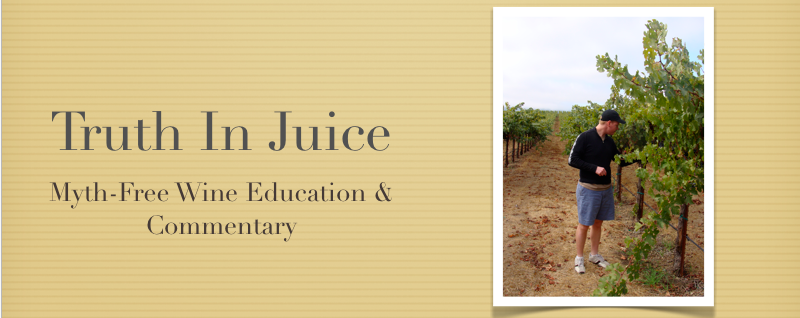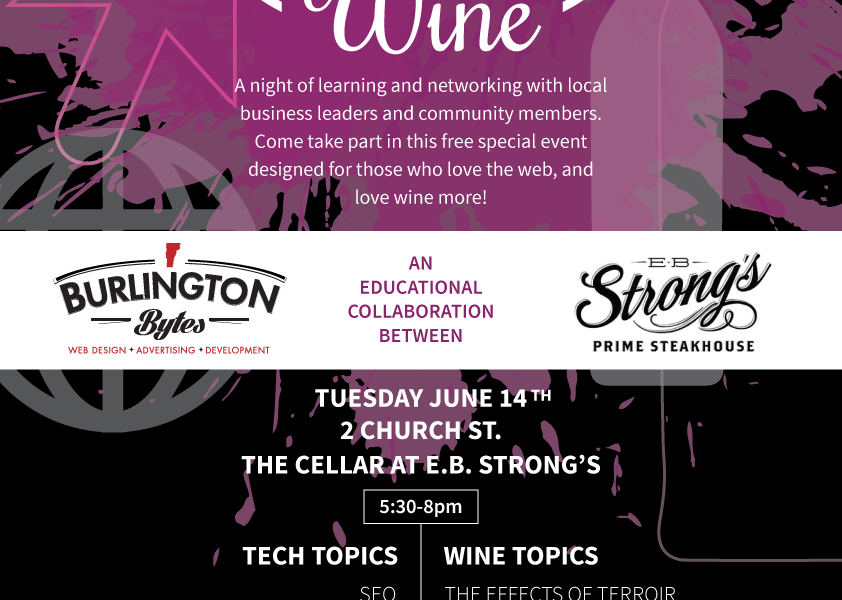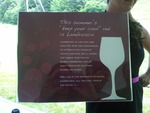Lambrusco: Wine Industry Promotion or Forgotten Gem?
 Wednesday, August 1, 2012 at 3:13PM
Wednesday, August 1, 2012 at 3:13PM As someone who likes to try new wines, and be on the cutting edge of emerging trends, a slight smile crossed my face when the lovely young women manning the Vinlandia USA table at the Killington Wine Festival began aggressively promoting Lambrusco, as I tasted through their portfolio at the Saturday Grand Tasting.
"You simply have to try Lambrusco," said one of the women. "It's a delicious, dry sparkling red."
Not to worry, I told her, I'd definitely be trying the Lambrusco. My philosophy of always being willing to try any wine that I'm offered when at a tasting nonwithstanding, I'm well aware of what Lambrusco is, and I've had several good experiences with it. I very much appreciated the Villa di Corlo Lambrusco Sorbara that was served at the Vinlandia USA table, but I also thought of the Lini Lambruscos that I occasionally enjoyed during the days that I worked at BRIX Wine Shop in Boston. I'd always enjoyed Lambrusco, but it wasn't something that I drank very often.
Still, I couldn't help battling a little skepticism, as other festival attendees approached the table, and were given the same spiel about the Lambrusco. Perhaps it was because I'd witnessed repeated efforts to attract people to the Lambrusco, but after one couple walked away without trying the Lambrusco, one of the women at the table addressed my girlfriend and I again. "It's the summer of Lambrusco," she declared, and pointed towards a placard on the table.
Somehow the sign had escaped my attention initially, but upon being directed towards it, I noticed that it did appear to advertise Lambrusco as being an en vogue item this summer.
"This summer's 'keep your cool' red is Lambrusco," read the sign. "Lambrusco is like the love child of wine and Champagne, an intoxicating union of tannin and fizz. Still under the radar, this Italian bubbly deserves just as much attention as other sparkling wines."
"Help us in the movement to revive Lambrusco, all the cool people are doing it..."
I left the table slightly befuddled and confused. Since when had the wine industry come together so strongly behind one particular kind of wine? I'd heard of Paul Greico’s "Summer of Riesling," started at Terroir Wine Bar in New York's East Village, and I knew it was common for those in the wine trade to champion the cause of grapes or styles of wine that had fallen victim to what I like to call "wine fashion." After all, rosé would likely have struggled to return to prominence without a dedicated effort from wine professionals to sever the psychological link between rosé and White Zinfandel. Yet, I didn't remember anything resembling a tactical marketing campaign accompanying rosé's resurgence. Perhaps it was romanticism, but I seemed to remember the rosé resurgence being the result of a grassroots effort, as wine merchants and avant garde wine consumers teamed together to change the fortune of a style of wine that they loved.
Upon returning home from the wine festival, I looked online, and found that there was indeed a website dedicated to the idea that 2012 was the "Summer of Lambrusco." The website quoted a Wine Spectator article from August, 2001, that extolled the merits of Lambrusco as a perfect summertime red. When Eric Asimov released an article this past Monday, entitled Lambrusco Wants You Back, I began to feel just a little bit bombarded with the Lambrusco agenda. To clarify, I have nothing against Lambrusco. I've had quite a few enjoyable experiences with it, and I'll happily drink good Lambrusco any night of the week. Yet, given the generally reserved nature of the wine press, the relative amount of encouragement to drink Lambrusco that I've encountered in the past 10 days is becoming tantamount to political ads in an election year. After you've heard the same message 5 or 6 times, you want to be able to filter out the commercials.
Still, I was somewhat intrigued by this seemingly concentrated effort to "revive Lambrusco." While I was searching for Asimov's latest article, I encountered a slew of prior articles that he had written, singing the praises of Lambrusco. In addition to the latest column, which described the results of a recent NY Times panel tasting of Lambrusco, there were articles from 2006 and 2007. Asimov wasn't alone in his affinity for Lambrusco. Lettie Teague had written an article entitled Riunite Was Nice, but There's More to Lambrusco in December of 2010. (Side note: Riunite is a brand of Lambruscothat was popular in the 1970s and 1980s. It was sweet, and most famous for it's slogan, "Riunite on ice…that's nice." In terms of disastrous effects on the future popularity of a style of wine, Riunite was toLambrusco what White Zinfandel was to rosé.) Finally, I was amazed to find that one Lambrusco producer (Pronto) had taken the trouble to catalogue Lambrusco's troubled history (and pending rehabilitation) in the U.S., in a page they called the Lambrusco Chronicles. In taking a brief read through the page, I noticed it mentioned another significant Lambrusco article that I hadn't come across, a 2006 piece from Jon Bonné in the San Francisco Chronicle entitled Paint the Town Red With Italian Bubbles. This too, described the disastrous effects of Rinunite on artisanal Lambrusco, as well as the latter's rehabilitation. However, it offered what I felt was a more realistic expectation of Lambrusco's success in the U.S. market. "Lambrusco's success will likely be modest," wrote Bonné. "Table wine it always was, and table wine it will remain."
After pondering the situation for a while, I couldn't understand why the effort to revive Lambrusco had taken so long, or why it was continually revisited by wine columnists, years after it had first begun. While this may be the "Summer of Lambrusco," the simple reality is that Lambrusco is a sparkling red, which is a tough style of wine to sell, even without the spectre of Riunite lingering over the wine. Sparkling Shiraz, is another sparkling red wine that has met with limited commercial success in the U.S., although skeptics would argue that Cold Duck irreversably tainted American perceptions of that style of wine. Asimov acknowledged in his latest column that most people would agree that Lambrusco still faces significant hurdles with consumers, quoting sommelier Levi Dalton as saying
“Vivace reds are the last frontier for American consumers. White, off-dry, savory and so on are now all accepted. The last thing is for wines with bubbles that are red.”
Asimov added that this "sounds like the fear factor at work," asking "what do Americans, a beer-guzzling, soda-swilling people, have to fear from a red with bubbles? Scorn from one’s peers for having selected the wrong wine?" Still, rosé was able to overcome the effects of White Zinfandel, and has become tremendously popular over the last several years, so what was the issue with Lambrusco?
My simple theory is that as a sparkling wine, consumers don't find occasion to drink Lambrusco as often as they should. Champagne and other sparkling wines are often lumped into the category of special occasion wines, and reserved for the holidays and other select events, despite the fact that they are among the most versatile food wines known today. Additionally, I have had friends tell me that they avoid sparkling wines because they don't enjoy the carbonation. Even I must admit that while Champagne is one of my favorite types of wine, I don't drink it as often as I used to, or as often as I should. If traditional sparkling wines are facing consumer resistance, what does that say for the chances of success for a lesser-known wine like Lambrusco?
In closing, I'd encourage you to seek out some Lambrusco, and give it a try for yourself, if you can find it. It's not a wine that is easily found in the supermarket, and even some boutique wine shops don't carry it. This doesn't mean that Lambrusco is bad wine. As I've said before, I genuinely enjoy Lambrusco, and will happily drink it. It's just that with so many other quality options available to me, it's not a wine that I drink very often. The success of retail shops depends on stocking wines that they can sell quickly, and without a customer base clamoring for Lambrusco, many will opt to avoid the financial risk of keeping it in stock. Still, I don't fault the efforts of those who are trying to "revive," or "rehabilitate" Lambrusco. They have obviously become very taken with the wine, and are trying to encourage others to adopt a similar sentiment. I'm adopting a similar approach with my upcoming tasting panel, where I'm attempting to gauge genuine consumer opinions of Chardonnay through a blind tasting of white wines. I don't want Chardonnay to be maligned unfairly, and I can honestly say the same for Lambrusco. I'm hopeful that it is able to overcome the negative perceptions that Riunite has bestowed on it. However, as someone who is fully bought into the merits of Lambrusco, I'm hopeful that its campaign takes on a more organic approach going forward.
 Eric Asimov,
Eric Asimov,  Lettie Teague in
Lettie Teague in  Rose,
Rose,  Wine Fashion
Wine Fashion 



Reader Comments